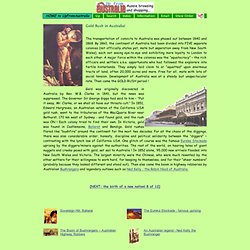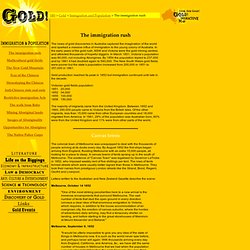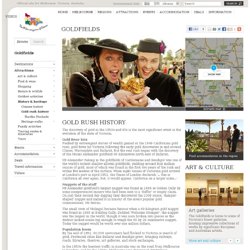

The Australian Gold Rush. American Experience.
Pics. Gold Rush in Australia! The transportation of convicts to Australia was phased out between 1840 and 1868.

By 1860, the continent of Australia had been divided into FIVE separate colonies (not officially states yet, mate but seperation away from New South Wales), each not seeing eye-to-eye and exhibiting more loyalty to London to each other. A major force within the colonies was the “squatocracy” – the rich officers and settlers a.k.a. opportunists who had followed the explorers into fertile hinterlands. They simply laid claim to or “squatted” upon enormous tracts of land, often 20,000 acres and more.
Free for all, mate with lots of social tension. Development of Australia was at a steady but unspectacular rate. Gold was originally discovered in Australia by Rev. [NEXT: the birth of a new nation! The Australian Gold Rush. Www.patricktaylor.com | articles First published April 28th, 2006 The Australian Gold Rush - Diggers (State Library of NSW) Many people associate the Gold Rush with California or the Klondike, but the Australian gold rush remains the world's richest.

The discovery of Australian gold Isolated gold finds had been reported in New South Wales since the 1820s, but it was another thirty years before a fully-fledged gold rush would take its hold on the British penal colonies in Australia. In February 1851 Hargraves took his pan and rocking-cradle and with his guide, John Lister, set out on horseback to Lewes Pond Creek, a tributary of the Macquarie River close to Bathurst. Word spread quickly and within a few days 100 diggers were frantically tunnelling for instant wealth.
Edward Hargraves did not make a fortune from gold. The discovery in New South Wales and the resulting rush of labour from the adjoining state of Victoria prompted the Governor of Victoria, Charles J. Goldrush.
~ GOLD ~ The news of gold discoveries in Australia captured the imagination of the world and sparked a massive influx of immigration to the young colony of Australia.

In the early years of the gold rush, NSW and Victoria were the gold mining centres and attracted thousands of hopeful diggers. In March 1851, Victoria’s population was 80,000, not including Aborigines. By 1854 the population tripled to 237,000 and by 1861 it had doubled again to 540,000. The New South Wales gold fields were poorer but the state’s population increased from 200,000 in 1851 to 357,000 in 1861. Gold production reached its peak in 1853 but immigration continued until late in the decade. Victorian gold fields population: The majority of migrants came from the United Kingdom. Canvas towns The colonial town of Melbourne was unequipped to deal with the thousands of people arriving at its docks every day.
Letters written to the Australian and New Zealand Gazette describe the scene: Melbourne, October 14 1852 Credits. Gold rush history, Goldfields. The discovery of gold in the 1850s and 60s is the most significant event in the evolution of the state of Victoria.

Fuelled by extravagant stories of wealth gained at the 1849 Californian gold rush, gold fever hit Victoria following the early gold discoveries in and around Clunes, Warrandyte and Ballarat. But the real rush began with the discovery of the Mount Alexander goldfield 60 kilometres north-east of Ballarat. Mt Alexander (taking in the goldfields of Castlemaine and Bendigo) was one of the world's richest shallow alluvial goldfields, yielding around four million ounces of gold, most of which was found in the first two years of the rush and within five metres of the surface. When eight tonnes of Victorian gold arrived at London's port in April 1852, the Times of London declared: '.. this is California all over again, but, it would appear, California on a larger scale…' The small town of Moliagul became famous when a 69-kilogram gold nugget was found in 1869 at Bulldog Gully.